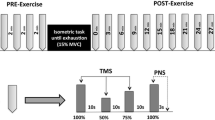Abstract
Fatigue of voluntary muscular effort is a complex and multifaceted phenomenon. Fatigue of peripheral nervous system components, including the contractile apparatus and the neuromuscular junction, has been well studied. Central nervous system components also fatigue, but studies have lagged for want of objective methods. Transcranial magnetic stimulation is a relatively new technique that can be used to assess central nervous system excitability from the motor cortex to the alpha-motoneuron. In six normal volunteers, including four of the investigators, the amplitudes of motor evoked potentials elicited by transcranial magnetic stimulation were transiently decreased after exercise, indicating fatigue of motor pathways in the central nervous system. The decrease in amplitude was associated with a feeling of fatigue. The mechanism of this phenomenon is apparently decreased efficiency in the generation of the motor command in the motor cortex.
Similar content being viewed by others
References
Amassian VE, Stewart M, Quirk GJ, Rosenthal JL (1987) Physiological basis of motor effects of a transient stimulus to cerebral cortex. Neurosurgery 20:74–93
Bigland-Ritchie B, Johansson R, Lippold OCJ, Woods JJ (1983) Contractile speed and EMG changes during fatigue of sustained maximal voluntary contractions. J Physiol (Lond) 340:335–346
Brasil-Neto JP, McShane L, Fuhr P, Hallett M, Cohen LG (1992) Noninvasive topographic mapping of the human motor cortex with a magnetic stimulator: factors affecting accuracy and reproducibility. Electroencephalogr Clin Neurophysiol 85:9–16
Brower B, Ashby P, Midroni G (1989) Excitability of corticospinal neurons during tonic muscle contractions in man. Exp Brain Res 74:649–652
Chiappa KH, Cros D, Day B, Fang J, MacDonell R, Mavroudakis N (1991) Magnetic stimulation of the human motor cortex: ipsilateral and contralateral facilitation effects. Electroencephalogr Clin Neurophysiol [Suppl] 43:186–201
Cohen LG, Bandinelli S, Topka H, Fuhr P, Roth B, Hallett M (1991) Topographic maps from human motor cortex in normals and pathological conditions: mirror movements, amputations, and spinal cord injury. Electroencephalogr Clin Neurophysiol [Suppl] 43:36–50
Dawson GD (1947) Investigations on a patient subject to myoclonic seizures after sensory stimulation. J Neurol Neurosurg Psychiatry 10:141–162
Day BL, Thompson PD, Dick JP, Nakashima K, Marsden CD (1987) Different sites of action of electrical and magnetic stimulation of the human brain. Neurosci Lett 75:101–106
Hallett M, Chadwick D, Marsden CD (1979) Cortical reflex myoclonus. Neurology 29:1107–1125
Halliday AM (1980) Cerebral somatosensory and visual evoked potentials in different clinical forms of myoclonus. In: Desmedt JE (ed) Clinical uses of cerebral, brainstem and spinal somatosensory evoked potentials. Karger, Basel, pp 292–310
Hess CW, Mills KR, Murray NMF (1986) Magnetic stimulation of the human brain: facilitation of motor responses by voluntary contractions of ipsilateral and contralateral muscles with additional observations on an amputee. Neurosci Lett 71:235–240
Merton PA, Morton HB, Hill DK, Marsden CD (1982) Scope of a technique for electrical stimulation of human brain, spinal cord and muscle. Lancet 2:597–600
Oh SJ (1988) Electromyography: neuromuscular transmission studies. Williams & Wilkins, Baltimore, pp 1–29
Reutens DC, Berkovic SF (1992) Increased cortical excitability in generalised epilepsy demonstrated with transcranial magnetic stimulation (letter). Lancet 339:362–363
Rossini PM, Caramia MD (1988) Methodological and physiological considerations on electric or magnetic transcranial stimulation. In: Rossini PM, Marsden CD (eds) Non-invasive stimulation of brain and spinal cord: fundamentals and clinical applications. Liss, New York, pp 37–65
Author information
Authors and Affiliations
Rights and permissions
About this article
Cite this article
Brasil-Neto, J.P., Pascual-Leone, A., Valls-Solé, J. et al. Postexercise depression of motor evoked potentials: a measure of central nervous system fatigue. Exp Brain Res 93, 181–184 (1993). https://doi.org/10.1007/BF00227794
Received:
Accepted:
Issue Date:
DOI: https://doi.org/10.1007/BF00227794




